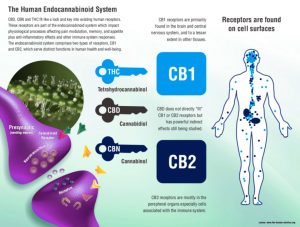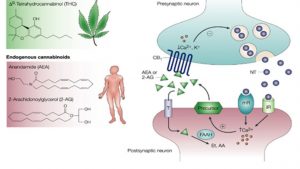What comes to mind when you think of the word marijuana? Gateway drug? Euphoria? Weed? Illegal? Schedule I drug? It is important to realize that there has been a dramatic increase in using marijuana for medicinal purposes in order to help relieve pain, help reduce anxiety and migraines, and other diseases such as cancer, Parkinson’s, and Epilepsy. So you may be asking yourself, “how can marijuana be beneficial?” and in order to answer this question we look to the endocannabinoid system in the body.
What is the Endocannabinoid system and why is it important?
In essence, endocannabinoids are lipid molecules that are produced in the body that interact with the cannabinoid system in order to help maintain stable conditions physiologically and act as neurotransmitters when needed. The two cannabinoid receptors that are involved in this story are CB1 and CB2 receptors and act as G-protein coupled receptors (GPCR). The CB1 receptors are more common and are mainly found in the central nervous system (brain), peripheral nervous system and other organs. The CB2 receptors, however, are less common and mainly found in the immune and gastrointestinal systems.

Common Endocannabinoid molecules
Anandamide (AEA) and 2-AG are both molecules derived from arachidonic acid and are known as retrograde neurotransmitters that essentially act backward from the post-synaptic neuron to the pre-synaptic neuron and decrease the amount of communication between neurons. This is what leads to the positive effects of pain relief, helping with anxiety, seizures, and even muscle spasms. When one of these endocannabinoids (made from body) or cannabinoids (from marijuana) binds to the receptor, the pathway that would otherwise be activated is now inhibited and cAMP is also inactive. This could lead to multiple cellular changes, including apoptosis, or cell death. This aspect of the endocannabinoids is extremely beneficial in cancer. Apoptosis happens due to the binding of the cannabinoid and an increase in ceramide synthesis, which leads to a stress response and causes cell death.

To legalize marijuana or not: that is the question.
In today’s society, we are constantly talking about whether to legalize marijuana, whether it is for recreational or medical purposes. Some states have decided to legalize the drug for recreational use while others have not. However, it is still illegal under the federal government. But do the benefits outweigh the risks? Should marijuana be legalized for recreational use or solely for medical purposes? Is it really a schedule I drug? Why is it SO HARD to study marijuana? I personally would like to see more research done with marijuana and the contents that come with the drug, especially as an aspiring physician. However, as the FDA classifies marijuana as a schedule I drug, it makes research on cannabis nearly impossible. This continues to frustrate me because it means that it is extremely difficult to learn more about the potential benefits from this drug from a research perspective. Research labs and scientists want to conduct research studies on cannabis, yet cant have easy access in order to do this. This seems to be the bigger problem that needs to be fixed and maybe one day, hopefully soon, more research on cannabis can become a reality.

To read more on the legalization of marijuana debate: https://drugabuse.com/voices-from-both-sides-of-the-medical-marijuana-debate/ or https://www.drugabuse.gov/publications/drugfacts/marijuana-medicine
Image 1: https://www.youtube.com/watch?v=MqxJ7tsBt0s
Image 2: https://musclemx.com/2018/03/24/11-mind-blowing-facts-about-your-bodys-endocannabinoid-system/
Image 3: https://www.sclabs.com/the-endocannabinoid-system-and-stress-related-psychiatric-illness/
Image 4: https://medium.com/ucsf-magazine/why-is-it-so-hard-to-study-marijuana-d7a17c206fe1
